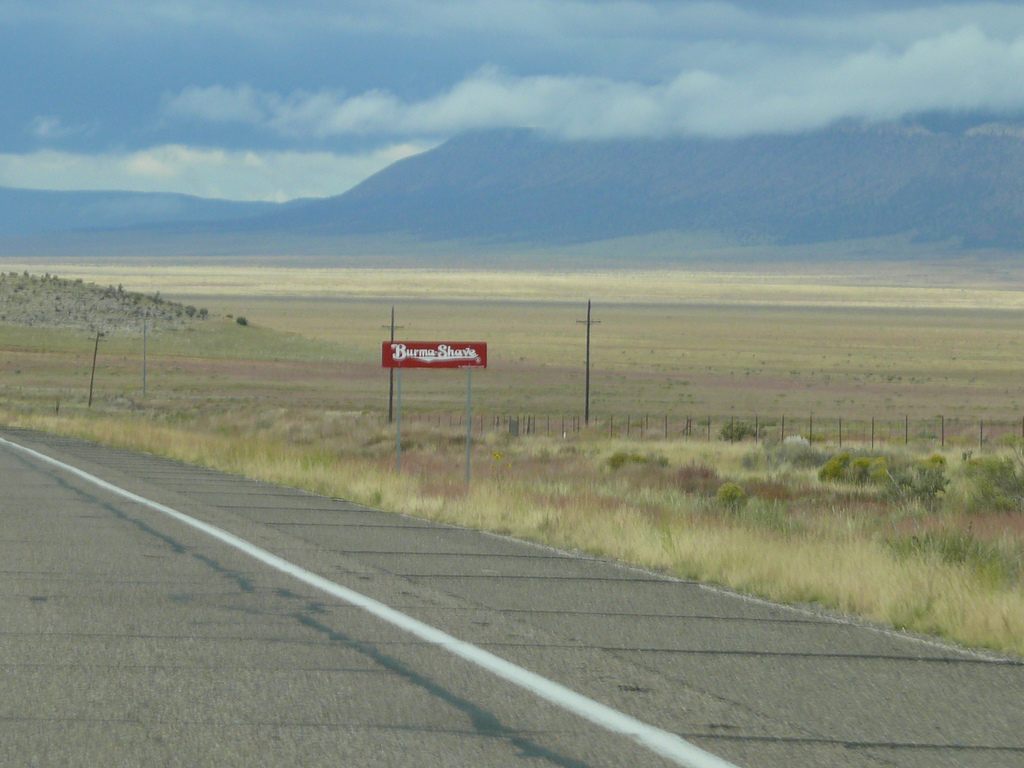The Weird Logic Behind Yard Signs in Politics
If they aren’t very effective, why are they so ubiquitous?

Political signs in Cleveland, Ohio. (Photo: Tim Evanson/CC BY-SA 2.0)
A version of this post originally appeared on Tedium, a twice-weekly newsletter that hunts for the end of the long tail.
In this age of absurd analytics, Twitter nontroversies, and over-the-top digital campaigns, it seems insane that a yard sign could have any effect on most people, especially for large-scale presidential campaigns.
For one thing, compared to tweets and social media platforms, such signs are not cheap. And they only show logos! There are no policy statements to be found anywhere on these signs.
But, for some reason, they persist. That’s despite the fact they’re not cheap.
How not cheap are we talking? Well, if you wanted to purchase 2,000 full-color, double-sided yard signs from the website Dirt Cheap Signs, you’d be paying $2.95 a pop—a price total that includes metal H-stakes to embed the signs into the ground. (The full cost of the sign buy is $5,900.)
Purchasing yard signs is a game of scale—buying just one doesn’t make a lot of sense, but buying thousands or tens of thousands is relatively cost-effective. In comparison, it costs a few hundred dollars to run a single local television ad, according to Entrepreneur.
But, on the other hand, there’s a lot less physical labor that goes into a televised campaign ad—you don’t have to shove 2,000 printed signs into the ground.
How effective are those signs, anyway? According to one study, the improvement is marginal, at best.
Columbia University researchers last year found that having yard signs out in force helped increase voter share by 1.7 percent.
The researchers told Politico that they were surprised by the modest finding—because they assumed the study would show that the signs had no effect at all.
“We were surprised by these findings, because the conventional wisdom is that lawn signs don’t do much—they’re supposed to be a waste of money and time. Many campaign consultants think that signs ‘preach to the choir’ and not much else,” co-author Alex Coppock told the website.
Still, 1.7 percent is not much to write home about—unless you’re running a tight race.

Signs for Bernie Sanders in Iowa. (Photo: Phil Roeder/CC BY 2.0)
Some political consultants, such as David Mowery of Mowery Consulting Group, aren’t convinced.
“Signs are a consultant’s nightmare and a print shop’s dream,” Mowery wrote in a blog post for Campaigns and Elections. “You can never have enough of them, they’re a drain on your campaign budget and your field staff (if the campaign is big enough to even have one), and they don’t do a damn thing for name ID, messaging, or [get out the vote].”
Such signage, he argues, is ineffective in a time when campaigns have become more sophisticated and data-driven.
And there’s another problem, too. “Beyond their lack of effectiveness, the other issue with yard signs is that they get stolen,” he adds.
The inefficiency of political signs as a form of marketing makes them the common targets of jokes. In October of 2008, for example, The Onion made a spot-on joke about political campaigning at John McCain’s expense.
The headline, “McCain Blasts Obama As Out Of Touch In Burma-Shave-Style Billboard Campaign,” suggested that the Republican candidate was using road signs as anti-Obama poetry, in a style similar to the shaving company’s long-running campaign, that lasted through the 1960s.
The joke—that McCain was relying on outdated marketing methods to campaign at a time when Obama was basically inventing the “big data” campaign—was worth a chuckle or ten.

A Burma Shave sign in Arizona. (Photo: Mark Cameron/CC BY-ND 2.0)
But hidden in the satire is a grain of truth. Burma-Shave did inspire political campaigning, because it highlighted just how effective signage could be in the right context.
The company, which had brought one of the first brushless shaving creams to the market, was struggling to reach its target audience, until Alan Odell, the son of the company’s owner, one day suggested making roadside signs that advertised the company.
He was given a couple of hundred dollars to try the idea out, putting the signs out in a remote part of Minnesota. Almost immediately, the sing-song ads had an effect on the company’s bottom line, and for the next 40 years, Burma-Shave was a constant on major roadways.
The interstate era ultimately did Burma-Shave in, forcing a change in tactics after the company was sold off.
But the campaign helped to show the value of small-scale signage, which ultimately has become a key element in modern political campaigns, Onion jokes aside.
And there’s even direct evidence that Burma-Shave had a direct effect on political campaigning. In Canada, the company directly inspired a political term, “burma-shaving,” which basically means that a candidate holds out one of their signs and shows off to passers-by, effectively creating a natural photo-op.
Jim Flaherty, Canada’s late finance minister, once recalled during a commencement speech at the University of Western Ontario having to do this on election day in 2008.
“While I don’t know if this technique actually gets you votes, I do know that it keeps nervous candidates busy and not bothering their campaign team, the ones doing the real work,” Flaherty noted in his speech.
These days, when most people think about political signs, they generally think about them in terms of the rectangular 18”x24” setup that has become the standard-bearer in yards around the country.

Steve Grubbs and Rand Paul. (Photo: Gage Skidmore/CC BY-SA 2.0)
Steve Grubbs, however, doesn’t think in those terms. The Republican political operative, who spent six years as an Iowa legislator in the ’90s and was once the head of the Iowa GOP, launched a company in 1999 called VictoryStore.com, and it’s treated him well ever since, earning revenue in the tens of millions during election years. To put it simply, Grubbs realized that die-cutting corrugated plastic into interesting shapes was the perfect way to create yard signs that stand out.
Grubbs, who also runs a political consulting firm, may be a strategist at heart, but as a side effect of being deep in the world of politics, he knows a lot about the processes that go into printing signs. In a 2013 YouTube clip, he explains exactly why these signs work so well for drawing attention, but also spends significant amounts of time discussing how great corrugated plastic is.
“We buy corrugated plastic by the truckload,” Grubbs explains in the clip. “During our busy season, we’ll have two semi-truckloads of corrugated plastic come in a week.”
Grubbs, who bought his old elementary school and turned it into his corporate headquarters (really), has become a master of wacky ideas, both political and non-political.
One of his firm’s related businesses sells massive novelty greeting cards, and ahead of political campaigns, his company often introduces new ways for candidates to get their messages across, such as life-size cutouts of people who represent certain demographics.
“If you want to talk to blue-collar voters, you buy the construction-guy cut-out,” Grubbs told the Wall Street Journal in 2010.
Grubbs’ power over the signage, as well as his politically convenient location, has made him something of a prominent figure in the political world. It also makes him a creative mind to be reckoned with. Just ask Rand Paul, who hired Grubbs as a consultant in 2014.
Grubbs took advantage of his wide knowledge of merchandising and used it to create a surprisingly impressive campaign store for Rand, one that included mock turtlenecks, Beats headphone skins, and Bluetooth-enabled teddy bears. At one point, it even included a mock hard drive, supposedly wiped of Hillary Clinton’s emails.
In an interview with Racked, Grubbs explained why Paul was putting so much energy into his store:
In a campaign store, you really have two goals. The first goal is to raise money to fund the campaign. The second goal is to use product in the store to help support the messaging from the campaign. That’s sort of where we have broken new ground. In the past, campaigns would just put up T-shirts, yard signs, and stickers. What the Rand Paul campaign decided to do was to make the store an extension of the messaging in the campaign. We don’t sell a lot of Hillary’s hard drive but it got a lot of publicity and it drove home the point about Hillary having that hard drive at home and not at the State Department.
(And in case you were wondering, Rand’s store also included some of Grubbs’ die-cut signs.)
Paul ultimately failed to get beyond Iowa, but it wasn’t because of his merch game. That was on-point—thanks to Steve Grubbs.
In a lot of ways, political yard signs—at least at the top of the ticket—are mainly of benefit for the people who want to put them in their yards. They show allegiance to their candidate and create a discussion point for those people. (Especially when used in YouTube skits involving 1,000 Ron Paul signs.)
As a result, It’s common for people to complain when their signs get stolen.
“Campaign signs don’t vote,” one letter-writer posited in a 2014 letter to the Spokane, Washington Spokesman-Review. “However, the people whose signs were stolen do vote, and do tell their friends and neighbors.”
These days, people who support causes are more likely to change their Facebook profile photos or retweet their candidate of choice, but perhaps the best evidence that physical yard signs still have their place comes from two different approaches to Trump campaign, both in Pennsylvania.
One couple, frustrated that their pro-Trump signs kept getting stolen, decided to build a wall around their sign to prevent its theft.
“Hey, you know, we’re just protecting our freedom of speech,” David Peters told WHP of the offbeat strategy.
The other strategy came about thanks to a Pittsburgh resident who decided that the Trump signs didn’t really speak to him. He decided to produce his own, complete with slogans designed to annoy the locals—“Trump Likes Hunt’s Ketchup,” “Trump Hates Pierogies,” “Trump Moved My Parking Chair.”
Eric Rickin, a psychiatrist, admits he was messing with people’s heads.
“I feel his whole campaign and his positions are absurd. But when you try to argue with logic, it doesn’t really work,” he told the Pittsburgh Post-Tribune.
Clearly, these folks have been reading the Burma-Shave guide to marketing.
A version of this post originally appeared on Tedium, a twice-weekly newsletter that hunts for the end of the long tail.











Follow us on Twitter to get the latest on the world's hidden wonders.
Like us on Facebook to get the latest on the world's hidden wonders.
Follow us on Twitter Like us on Facebook